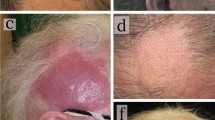Abstract
Background
A study of the scalp in a large cohort of volunteers with androgenetic alopecia using macrophotographs showed the presence of peripilar signs (PPS) around the hair ostia.
Objective
The aim of the present study was to establish the histopathological features related to PPS.
Design
Prospective clinicopathological study.
Setting
Department of Dermatology, University Hospital of Bologna.
Patients
A group of 40 patients (21 males and 19 females) participated in the study. Macrophotographs of the scalp were taken using a Dermaphot camera and PPS were scored using a three-point scale. Hair density and PPS were clinically scored according to reference scales. Two punch biopsies from the photographed area were obtained from each subject and histological analysis was performed on vertical and horizontal sections.
Observations
Clinical parameters indicated that PPS were already detectable on scalp with high hair density. Moreover, in patients with high hair density (score >4), a significant relationship was found between the PPS score and the global score for perifollicular infiltrates. Thus PPS are linked to superficial perifollicular lymphocytic infiltrates in early androgenetic alopecia.
Conclusions
PPS could be the clinical signs reflecting the presence of perifollicular infiltrates.










Similar content being viewed by others
References
Abell E (1988) Histologic response to topically applied minoxidil in male-pattern alopecia. Clin Dermatol 6:191–194
Cerio R, Griffiths CE, Cooper KD, Nickoloff BJ, Headington JT (1989) Characterization of factor XIIIa positive dermal dendritic cells in normal and inflamed skin. Br J Dermatol 121:421–431
Commo S, Bernard BA (1997) Immunohistochemical analysis of tissue remodelling during the anagen-catagen transition of the human hair follicle. Br J Dermatol 137:31–38
De Lacharrière O, Deloche C, Bastien P, Tardy I, Galan P, Hercberg S (2001) Perifollicular signs during male androgenic alopecia. Evolution risk factors for androgenic alopecia. J Eur Acad Dermatol Venereol 15s:134
De Lacharrière O, Deloche C, Misciali C, Piraccini BM, Vincenzi C, Bastien P, Tardy I, Bernard BA, Tosti A (2001) Hair diameter diversity. A clinical sign reflecting the follicle miniaturization. Arch Dermatol 137:641–645
Hamilton JB (1951) Patterned loss of hair in man: types and incidence. Ann N Y Acad Sci 53:708–728
Headington JT (1984) Transverse microscopic anatomy of the human scalp. A basis for a morphometric approach to disorders of the hair follicle. Arch Dermatol 120:449–456
Hercberg S, Preziosi P, Briançon S, Galan P, Triol I, Malvy D, Roussel AM, Favier A (1998) A primary prevention trial using nutritional doses of antioxidant vitamins and minerals in cardiovascular diseases and cancers in a general population: the SU.VI.MAX study—design, methods, and participant characteristics. Control Clin Trials 19:336–351
Jaworsky C, Kligman AM, Murphy GF (1992) Characterization of inflammatory infiltrates in male pattern alopecia: applications for pathogenesis. Br J Dermatol 127:239–246
Kligman AM (1988) The comparative histopathology of male-pattern baldness and senescent baldness. Clin Dermatol 6:108–118
Lattanand A, Johnson WC (1995) Male pattern alopecia: a histopathologic and histochemical study. J Cutan Pathol 2:58–70
Ludwig E (1977) Classification of the types of androgenetic alopecia (common baldness) occurring in female sex. Br J Dermatol 97:247–254
Mahe YF, Michelet JF, Billoni N, Jarrousse F, Buan B, Commo S, Saint-Léger D, Bernard BA (2000) Androgenetic alopecia and microinflammation. Int J Dermatol 39:576–584
Schreck-Purola I, Lindroos B, Nordström R, Setälä K (1981) Hair neogenesis in man: a histoquantitative study based on 1000 scalp biopsies. In: Orfanos CE, Montagna W, Stüttgen G (eds) Hair research. Status and future aspects. Springer-Verlag, New York, pp 344–349
Solomon AR (1992) Alopecia by a different name: a matter of splitting hairs. Arch Dermatol 128:102–103
Sperling LC, Winton GB (1990) The transverse anatomy of androgenetic alopecia. J Dermatol Surg Oncol 16:1127–1133
Sueki H, Stoudemayer T, Kligman AM, Murphy GF (1999) Quantitative and ultrastructural analysis of inflammatory infiltrates in male pattern alopecia. Acta Derm Venereol 79:347–350
Toida M, Watanabe F, Tsai CS, Okutomi T, Tatematsu N, Oka N (1989) Factor XIIIa-containing cells and fibrosis in oral and maxillofacial lesions: an immunohistochemical study. Oral Surg Oral Med Oral Pathol 68:293–299
Toida M, Okumura Y, Takami T (1991) Cells containing factor XIIIa and pulmonary fibrosis induced by bleomycin. J Clin Pathol 44:255–256
Whiting DA (1993) Diagnostic and predictive value of horizontal sections of scalp biopsy specimens in male pattern androgenetic alopecia. J Am Acad Dermatol 28:755–763
Whiting DA (2002) Inflammation and hair loss. 20th World Congress of Dermatology, Paris, 1–5 July
Young JW, Conte ET, Leavitt ML, Nafz MA, Schroeter AL (1991) Cutaneous immunopathology of androgenetic alopecia. J Am Osteopath Assoc 91:765–771
Author information
Authors and Affiliations
Corresponding author
Rights and permissions
About this article
Cite this article
Deloche, C., de Lacharrière, O., Misciali, C. et al. Histological features of peripilar signs associated with androgenetic alopecia. Arch Dermatol Res 295, 422–428 (2004). https://doi.org/10.1007/s00403-003-0447-y
Received:
Revised:
Accepted:
Published:
Issue Date:
DOI: https://doi.org/10.1007/s00403-003-0447-y




